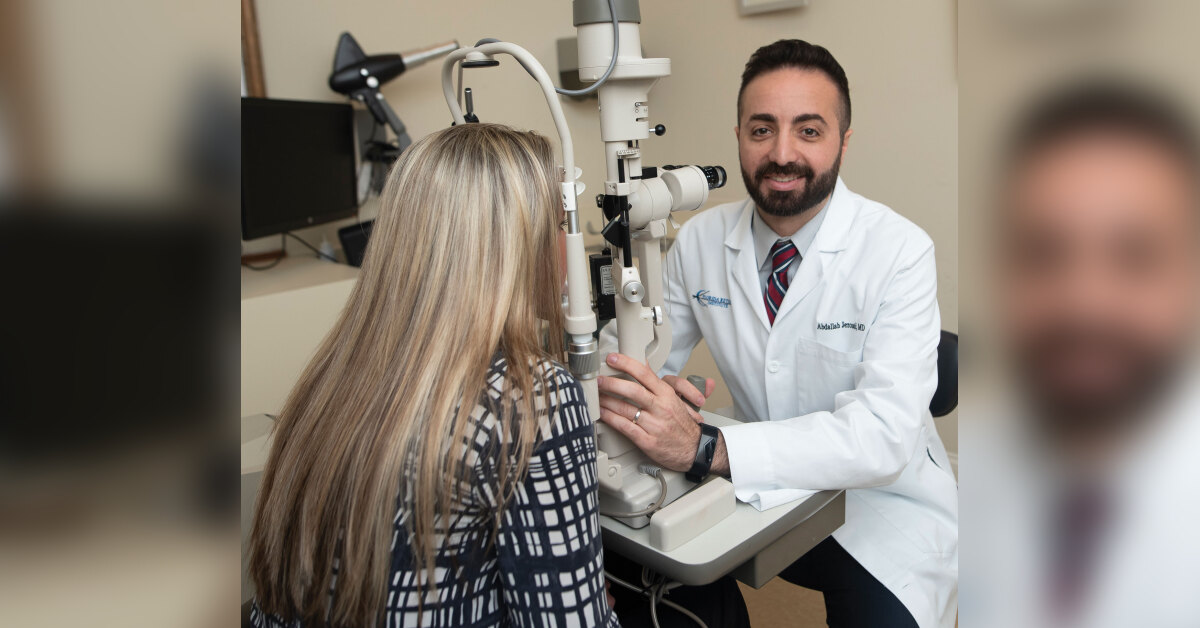The human eye is an amazing organ. Light enters through the pupils, is focused by the lens and is converted by the retina into nerve signals understood by the brain, which turns the signals into images. But sometimes, the brain sees irregular smudges hovering in the vision. These are eye floaters.
“Eye floaters are due to an opacity that occurs in the center part of the eye, specifically in the area behind the lens and in front of the retina,” describes Abdallah M. Jeroudi, MD, a board-certified, fellowship-trained retina specialist at Florida Retina Institute. “This area is filled with a jelly-like substance called vitreous humor.
“There are many reasons eye floaters develop, the most common being that the vitreous humor naturally degrades over time, and the jelly begins to liquify. The liquified form of the vitreous can be perceived as string-like or hair-like floaters.”
String-like floaters are rather common and usually benign. Many people start to see them when they reach their 20s and 30s, but most get accustomed to them.
Over time, the brain realizes that the person has floaters and that they typically hang out in certain areas of the eye and ignores them.
“We do not generally recommend treatment to remove these floaters because they tend to dissipate naturally,” Dr. Jeroudi notes. “The body will absorb them or the brain will learn to disregard them. But there are different types of floaters that can be dangerous.
“Dangerous types include a sudden onset of floaters or those that appear as a shower of numerous floaters or large, thick, ribbon-like floaters. Floaters that are different than the ones they are accustomed to seeing can be concerning.”
People who experience sudden onset or new, numerous or large floaters should call their eye doctors immediately and consult with the retina specialists at Florida Retina Institute. Floaters like these can be symptoms of retinal tears or detachments, which are serious eye disorders.
“Along with numerous floaters, people should be aware of multiple flashing lights that look like comet streaks or lights from a camera flash,” Dr. Jeroudi states. “These can be signs of tension on the retina, which can lead to a retinal tear. The appearance of a curtain drawn across the vision may indicate a retinal detachment.”
Retinal Repairs
If people suffer a sudden onset or numerous floaters, the retina specialists at Florida Retina Institute prefer to examine them within one to two days after symptoms begin to test for a retinal tear or detachment. If the diagnosis is a retinal tear, it can be treated with one of two in-office procedures.
“The goal of treatment for a retinal tear is to seal the tear and prevent its progression to a retinal detachment,” Dr. Jeroudi relates. “It is much like having a tear in wallpaper. If a person picks at that tear, they can pull all of the wallpaper off of the wall. With a retinal tear, the retina can be pulled off of the back wall of the eye. That’s a retinal detachment, and it can cause blindness.
“There are two basic methods for treating a retinal tear. One is a laser treatment. Using this approach, we apply several rows of small laser spots around the tear, which act as a glue or tiny pushpins to seal the edge of the tear. Imagine putting pushpins around the tear in the wallpaper. The wallpaper cannot be pulled back past the pushpins.”
The second way of treating a retinal tear is with a procedure called cryoretinopexy.
“During cryoretinopexy, we use a probe to make an indentation on the eye wall, then we provide a spot of freezing treatment, which creates an ice ball that forms an adhesive seal around the tear,” Dr. Jeroudi explains.
“Cryoretinopexy is much like the laser treatment except it is performed using a probe externally, whereas the laser is performed using laser light applied through the pupil. The premise of the two procedures is the same, however: to create a seal around the tear so it does not progress to a retinal detachment.”
Retinal detachments occur when the retina falls off of the back wall of the eye. This is a problem because part of the retina’s nourishment comes from being against the back wall. If the retina remains detached for a period of time, it could lead to vision loss. If it remains detached for a long time, such as several months, the condition could be irreparable.
“We repair retinal detachments by re-adhering the retina to the back wall of the eye,” Dr. Jeroudi observes. “A certain subset of patients can be treated in the office. In very specific circumstances, we can inject a gas bubble into the eye, which helps hold the retina against the back wall, then we perform the laser or freezing treatment.”
Most retinal detachments, however, require surgery in an operating room. The procedure is generally performed as an outpatient surgery. Patients enter the hospital and go home the same day.
“The procedure we perform is called vitrectomy,” the doctor educates. “During this procedure, we make tiny incisions through the wall of the eye and remove the vitreous jelly and any floaters in the way so we can access the retina. Then we smooth the retina against the back wall of the eye. It is like smoothing wallpaper on the wall in a room.
“Next, we perform the laser treatment to seal the tear that initiated the detachment. Then, we inject a gas bubble to hold the retina in place. The gas bubble enables the retina to heal in its proper position, and it naturally dissipates over several weeks.”
Precious Sense
Most simple, string-like eye floaters occur due to the degradation of the aqueous humor. Others form from a tear or detachment of the retina. Floaters can also occur due to an underlying disease process.
“Sometimes, people with diabetes, especially those who have had diabetes for a very long time or have a history of poorly controlled diabetes, can develop eye floaters,” Dr. Jeroudi reports.
“But they are a different type of floater. In this case, dangerous blood vessels form in reaction to chronically high blood sugar, and they can rip and fill the eye with blood. We tell all our patients with diabetes who get sudden floaters to have their eyes examined to look for this complication.”
Dr. Jeroudi stresses that people who experience sudden or numerous eye floaters, flashing lights or a sense that a shade has been drawn across their vision should not hesitate to call their doctor immediately.
“When this occurs, eye doctors want to be called so they can begin treatment and hopefully stop potential vision loss,” he encourages. “Patients experiencing those symptoms should never feel like they’re bothering their physicians by contacting them immediately. Their vision is too precious to wait.”







